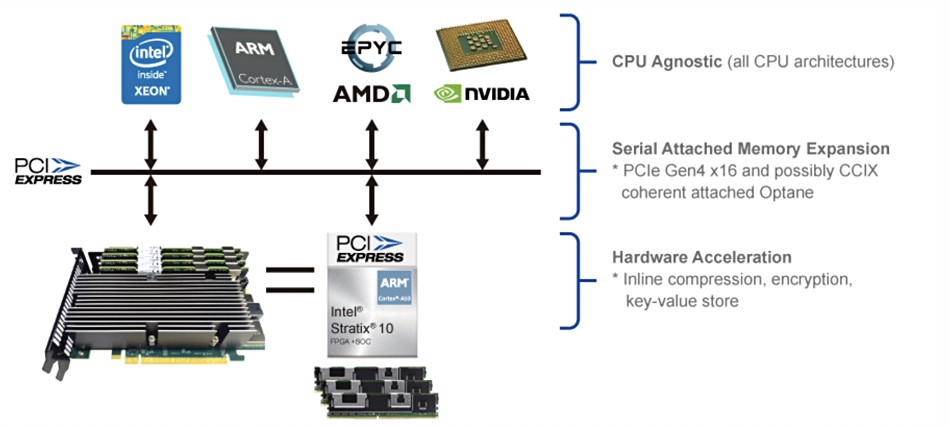System-on-chip builder SMART Modular Technologies has a PCIe card that it says opens up Optane memory use to AMD, Arm and Nvidia GPU servers.
Optane persistent memory (PMem) DIMM products are only directly supported by gen 2 (Cascade Lake) and later Xeon CPUs as they have certain Optane PMem controller functions embedded inside their chip and communicate with PMem products using the DDR-T protocol. That has meant AMD, Arm and Nidia GPU servers could not be fitted with Optane PMem products.
The Kestral AIC card contains 2TB of Optane DIMMs, an Intel Stratix-10 DX FPGA, and a 4-core Arm A53 SoC with dedicated on-board 2GB DDR4 memory and 8GB of eMMC storage acceleration. It has a PCIe-Gen4-x16 or PCIe-Gen3-x16 interface independent of the motherboard CPU. The two use cases are memory acceleration or system acceleration through computational storage.

SMART Modular’s VP Engineering Mike Rubino said: “With the advancement of new interconnect standards such as CXL and OpenCAPI, SMART’s new family of SMART Kestral AICs addresses the industry’s need for a variety of new memory module form factors and interfaces for memory expansion and acceleration.”
Kestral comes in a Full-Height, Half-Length (FHHL) dual slot form factor with less than 150W Thermal Design Power (TDP) using a passive heatsink. There are four DIMM slots with two independent channels, which can be populated with up to four Optane DIMMs up to 512GB each or two DDR4 RDIMMs up to 256GB each. The card’s latency is <350ns.
SMART said that its future AICs “will be capable of supporting 4TB of Optane Memory in persistent App Direct Mode via normal load/store semantics for all CPU architectures.” The Kestral product web page and downloadable technical brief contain some details about these two use cases but leave several questions unanswered.
The technical brief’s memory expansion diagram mentions CCIX.

CCIX was a server-memory bus development standard effort from 2020 providing cache-coherent memory. It was accompanied by the CXL, Gen-Z, and OpenCAPI alternatives. CXL absorbed the Gen-Z group and has emerged triumphant with CCIX and OpenCAPI relegated to niche applications.
SMART’s diagram says: “PCIe Gen4x16 and possibly CCIX” as if it’s not a done deal. We’ve asked SMART to explain what’s going in here. And we have also asked what software is necessary on the AMD, Arm, and Nvidia systems to support the Kestral card’s Optane memory as an adjunct to the host’s own DRAM.
This diagram also covers the computational storage use case with the FPGA capable of carrying out hardware-accelerated compression, key value store compaction, encryption and RAID 1 calculations.








